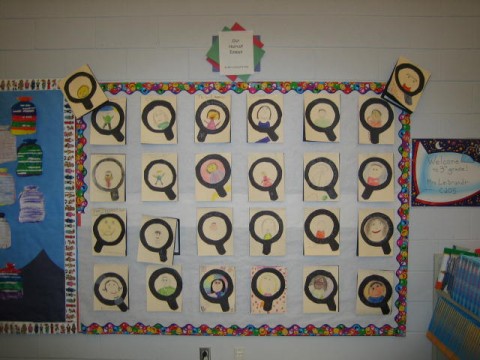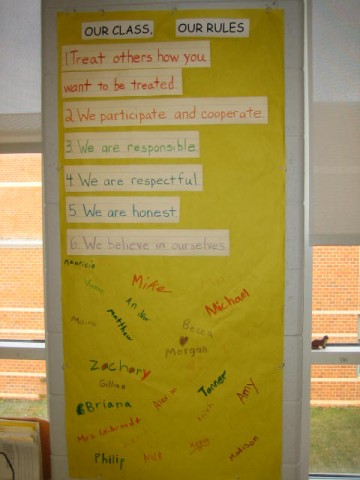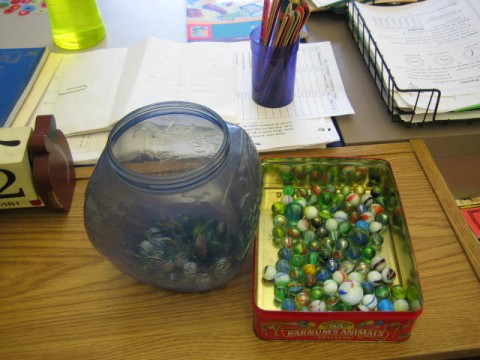Submitted for Graduation, May 2005
B: Classroom Management
classroom organization | seating arrangements | books,
books, books | student work | classroom rules | the
chip system
cash-in | the marble
jar | responsibility chart | procedures | discipline
problems | charlie | claire
| reflection | references
 |
 |
Classroom Organization: Welcome to my classroom! When you enter, you will feel welcome. This is not only my students' home, but it is my home. I strive to make my classroom a place where students are happy to arrive, sad to leave, and excited to return the next day. As you enter my classroom, you see students busy at work. They are not looking for me to tell them what to do. Instead, they are all engaged in the choices that they made independently.
Seating Arrangements: You will notice that the students work in cooperative groups of four to five students. I change the students' seats every six weeks. I want to give the students the opportunity to work with everyone in the class. The students learn prosocial skills by working in cooperative groups. I teach them strategies to help them solve their problems and use their work time efficiently. During Writing and Reading Workshop, the students are allowed to move freely around the room. Since the students switch teachers for reading, they share their desks with others. Sharing desks continues to teach prosocial skills and teaches the students to respect the property of others. When I differentiate instruction, I usually meet with a small group at the back table. I am fortunate to have two chalkboards in my classroom. I arranged a small table in front of the back chalkboard to use for instruction with the small groups (see pictures below). The Reading Workshop Schedule and Workboard Chart are hung on the front board, so the students who are working independently do not need the same space as the small group.
 |
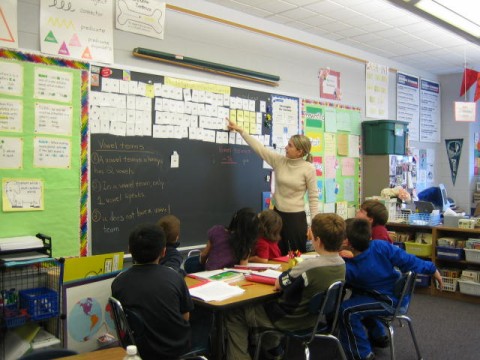 |
Books, Books, Books: As stated in My History in the Profession, I love books! Therefore, I've worked diligently to create a large classroom library that contains a variety of genres, authors, and reading levels. I want my students to be excited about reading. I feel that sharing the classroom library helps foster that excitement. I explain to the students how I've worked to create the classroom library. I also tell them that I will share it with them if they agree to treat the books with respect. This is a great lesson in sharing and responsibility. Parents also help the library grow. At Back to School Night, I explain that our class will participate in Scholastic Book Clubs. As parents buy books for their children, they earn points for the class. Then I use those points to add books to the library. I allow the students to make requests for the books I add to the library. Therefore, the library begins to reflect their interests.
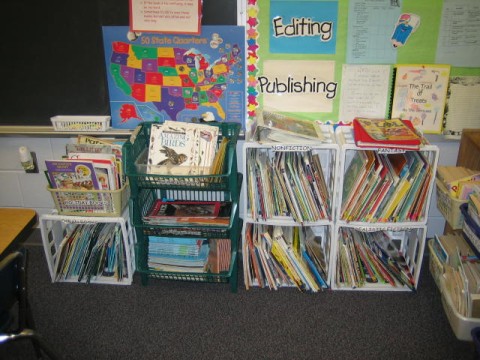 |
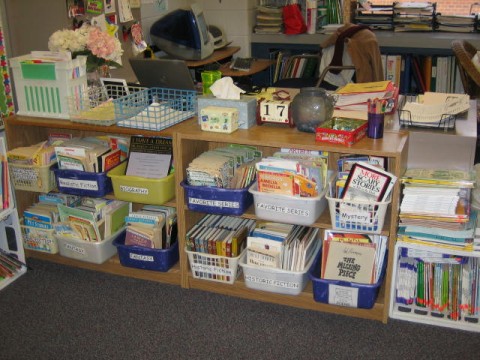 |
In addition to maintaining a large classroom library, I want the students to enjoy the time they spend reading. I made pillows that they are allowed to use when they read. I explain that I expect them to share the pillows and treat them with respect. They are allowed to take the pillows around the room to read. They are also allowed to read in the Author's Chair. This is the chair that I use when I do Read Alouds and the chair where the students share their writing.
 |
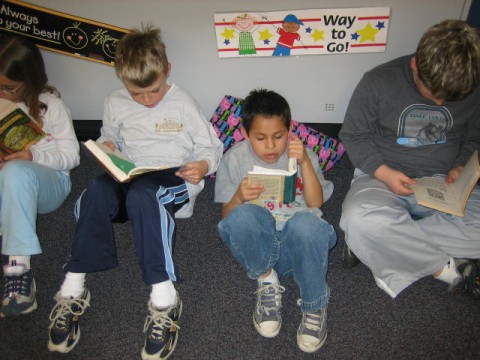 |
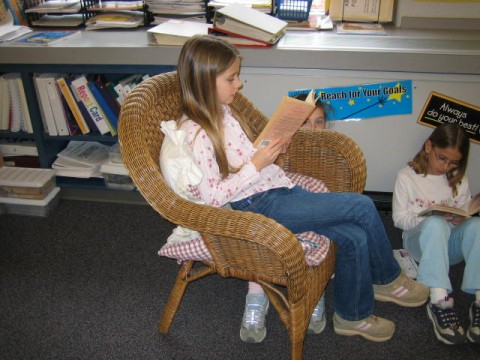 |
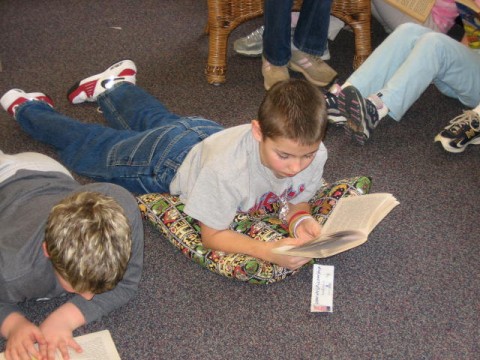 |
The Chip System: In order to hold the students accountable, I have created a token system. On Monday, the students receive five chips (see picture below on left). When I give the students the chips, I tell them that this shows that I expect them to follow the rules for everyday of the school week. If they do not follow the rules, they will be held accountable by giving me a chip. For example, for rule number three, we are responsible, the students know that this entails completing homework and bringing it to school. If they do not do this, they have to give me a chip. I do not go to them and ask for the chip. Instead, they come to me and tell me they forgot their homework. This helps them to learn to accept responsibility for their actions. If students do an excellent job following the classroom rules, they can earn extra chips.
Cash-In: On Friday, we have Cash-In. The students can cash-in their chips for a snack, stickers, computer time, picnic in the classroom, treasure chest item, or classroom artist. They do not have to cash-in on Friday. They can choose to save their chips. This not only gives the students incentives to follow the classroom rules, but it helps them learn to plan for goals. The students are very motivated by this system.
 |
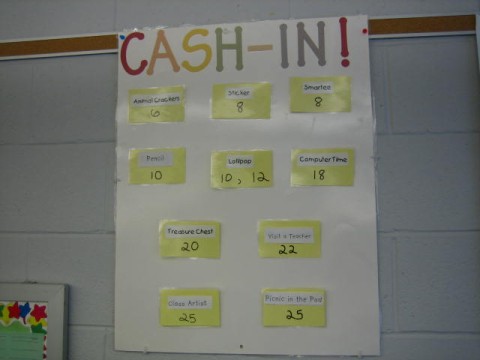 |
Responsibility Chart: In order to foster responsibility within my students, I created a Responsibility Chart. This is the same thing as a job chart. However, I feel that calling it a Responsibility Chart changes the meaning. The students learn that they all have responsibilities to the community. The students rotate through the responsibilities on a weekly basis. They do not pick what they'd like to do. Instead, every student has a turn at every responsibility. Some of the responsibilities are Assistant (my helper, line leader), Botanist (takes care of the plant), Clerks (pass out papers), Custodians (keep the room clean), Librarians (take care of the classroom library), Plumber (take care of the sink), and Mathematicians (take care of organizing the math manipulatives). Allowing the students to have responsibilities in the classroom truly empowers them. They truly take pride in the classroom and keep each other responsible for maintaining the classroom environment.
Procedures: As stated in Assessment, Planning, and Instruction, classroom procedures allow for success with my Reading Workshop and differentiation of instruction. Starting on the first day of school, I begin teaching my students how to work independently. I begin by teaching the students "How to Buzz" (Fountas and Pinnell, 2001.) This lesson teaches the students how to monitor their noise level while they are working with others. Establishing this expectation allows students to work on a variety of activities while the room remains quiet. Therefore, I am able to teach guided reading groups while the rest of the class is engaged in other activities. This takes a lot of practice and monitoring, but the end result is worth the student training.
After I teach the students how to buzz, I begin to teach them to rotate through activities. At first, I teach them the meaning of every Reading Workshop and Workboard icon one by one. At first, I use a timer to teach them to move from activity to activity. As they become more independent, they do not need the timer. All of this teaching, modeling, and practice takes approximately two months. This is a grueling process, but after two months, the students have become successful independent workers. I continue to monitor the students and give them feedback. Substitute teachers tell me that they do not need to be in the classroom because the students understand their expectations. Year and after I receive the same compliment, so I know that the training is well worth all of the effort.
I always teach the students what they are allowed to do if they finish an assignment early. For example, during Math Workshop, if the students finish an assignment, they are allowed to practice multiplication flashcards, play a previously taught math game, or work in their multiplication practice packet. In Writing Workshop, if they finish their assignment, they are allowed to work on another writing piece, write in their journal, or work in their creative writing packet. The students do not need to look to me to determine what they should do next. Instead, they make appropriate independent choices. All of this allows me to meet with small groups to differentiate my instruction to meet all of my students' needs.
Technology: I feel fortunate to have three computers in my classroom. One of the computers in connected to an Earthwalk. This enables me to demonstrate how to use the internet, introduce webpages, and teach programs to the entire class. One of the Workboard activities is computer use. I change the computer activity on a weekly basis to connect with the concepts I teach. Therefore, every student uses the internet/computer on a weekly basis. My goal is to increase my students' use of technology. I am excited that I am able to provide my students with technological literacy. I also feel fortunate because I wrote a grant and received a digital camera and a scanner. These tools allow me to chronicle the students and their work throughout the year. I post the pictures on my webpage, and I create a classroom scrapbook. In addition, my team collects images of the students throughout the year. At the end of the year, we create a PowerPoint presentation for the students and parents. This helps create a positive classroom and school environment. This year, I wrote a grant for a SMART board. I feel that this interactive whiteboard could enable me to continue to develop my students' technological literacy and enhance my teaching. I look forward to the opportunity to use this tool in the future.
Discipline Problems: Although we establish classroom rules and my students are aware of classroom expectations, discipline problems arise. As stated in my Professional Beliefs, I try to determine the root of a problem so I can help my students. If a student is having a problem, my first step is to speak to the student. I make the student aware of the problem, and we discuss causes and solutions. I do this because I want to give the student the opportunity to fix the problem. Then I allow the student time. If the problem escalates, I involve the parents. I also seek the help of other teachers, the Instructional Support Teacher, and at times, the principal. To explain this process, I will focus on how I handled problems with two different students. The names of the students are changed to protect their privacy.
Charlie: Charlie arrived midway through the school year. I received paperwork stating that Charlie enjoys school and has a positive attitude. However, after Charlie's first week, I wondered if I received the right paperwork. Charlie did not complete one homework assignment, he didn't participate in class, and he didn't smile. I was very concerned, so I began my first step. I took Charlie aside and talked with him. I explained my expectations and gave him encouraging words. After another week of the same behavior, I knew our talk didn't work. I knew I needed to contact his mom. I learned that Charlie's mom spoke only Spanish. Luckily, I can speak and write some Spanish, so I wrote her a note in the assignment book. She responded back immediately and explained that Charlie was struggling with the homework. I gave Charlie some extra help, but the same behavior continued for two more weeks. After talking with some other teachers, I decided that a phone call needed to be made. At AGIS, we have a translator who makes telephone calls to Spanish speaking parents. I explained the situation to the translator, and she made the phone call. Charlie's mom was very receptive and explained that Charlie was having difficulty with his work. We decided that we needed to create an IST plan to help Charlie with his learning needs. Therefore, I met with the IST teacher, and we began the paperwork for that process to begin.
Soon after that phone call, we began a new unit in math. Charlie started the unit with the entire class, and he seemed to grasp some of the concepts. I also placed him in a math support group with the IST teacher. He received extra math support three times a week. Suddenly, Charlie began coming to school with his homework. At first, he only had one of the assignments, but I praised him and gave him chips. Then he started doing two of the homework assignments. I continued with praise and chips. He loved Cash-In, and I learned that he was very motivated by earning chips. He loved earning them instead of having to give them to me for a lack of responsibility. I also began writing positive notes home in Spanish so his mom would be aware of his progress.
Now Charlie completes all of his homework every night. If he cannot complete his homework, his mom writes me a note explaining the reason. Then I can give him additional help or time in school. Charlie is not that student that I read about a few months ago. He enjoys school and displays a positive attitude. Just last week I heard the librarian say to him, "You are always smiling Charlie. I really like that." Now I know he's on the right track.
Claire: Claire was a very immature and impulsive student. She had a very difficult time learning to control herself. She would call out during lessons, disturb other students, and hand-in incomplete classwork. Once again, I took her aside and explained my expectations. However, she did not think that she had a problem. Therefore, I immediately made a phone call to her mom. Her mom explained that she had a problem with Claire at home. We decided that we would join forces to try to solve the problem together. Claire's mom and I decided to use a rating system. At the end of the school day, Claire would rate her behavior on a scale from 1 to 10. One was completely off-task and ten was completely focused and well-behaved. Then I would rate her day. Mom and I agreed that Claire needed to learn to be aware of her inappropriate behavior and that is why we allowed her to rate her day before I did. We wanted her to learn the specific behaviors that were causing her to get into trouble. Claire and I wrote the scores in her assignment book so her mom could see them at home. If Claire and I had the same score, Claire would earn a chip in school, and a star on a home chart her mom made. Claire also completed the same activity with her mom at the end of the evening. She rated her behavior at home. The important part of the scoring was that when our scores didn't match, we discussed the reasons. We wanted Claire to learn what she needed to improve. When she completed a row on the chart, she would earn a reward at home. Claire was very extrinsically motivated, so the chips and star chart was very motivating for her.
There were many weeks when our scores didn't match, but when Claire finally learned why her behaviors were inappropriate, she starting making growth. Awareness was the key to Claire's success. I'm very excited because Claire is still successful. When I told her fourth grade teacher about the rating scale, she was very surprised. She said that Claire was a very mature student and an excellent independent worker. I realized that the intervention was truly successful for Claire.
Reflection: By reflecting on Charlie, Claire, and all of the discipline problems I've encountered over the years, I realize that the key to success is collaboration. Discipline problems can be overwhelming. I've learned that I do not have to solve the problems by myself. I can seek help from other teachers and parents to help work through the problems. I find that I am only truly successful when I seek help from others. I try to take the puzzle pieces of a problem and fit them together, but another set of eyes always helps me put the pieces together the right way.
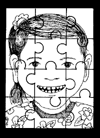
References
Fountas, I., & Pinnell, G. S. (2001). Guiding readers and writers (grades 3-6): Teaching comprehension, genre, and content literacy.
Portsmouth, NH: Heineman.
Clipart from Discovery School.
